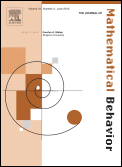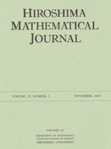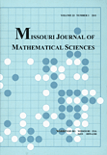
Journal of Mathematical Behavior
Scope & Guideline
Fostering Effective Learning in Mathematics
Introduction
Aims and Scopes
- Mathematical Understanding and Cognition:
The journal investigates how students and teachers conceptualize and understand mathematical ideas, including reasoning, problem-solving, and the development of mathematical thinking. - Teaching Practices and Pedagogical Strategies:
Research on effective teaching methods, instructional strategies, and interventions that promote student engagement and understanding in mathematics. - Equity and Diversity in Mathematics Education:
Exploration of issues related to equity, access, and the experiences of diverse student populations in mathematics education. - Integration of Technology in Mathematics Learning:
Studies on the use of digital tools and resources in teaching and learning mathematics, including the impact of technology on student understanding and engagement. - Historical and Cultural Contexts of Mathematics Education:
Examination of how historical and cultural factors influence mathematics teaching and learning, and the relevance of context in the understanding of mathematical concepts. - Qualitative and Quantitative Research Methodologies:
The journal publishes studies utilizing both qualitative and quantitative research methods to provide comprehensive insights into mathematical behavior and education.
Trending and Emerging
- Student-Centered Learning and Agency:
Increasing emphasis on student agency, voice, and personalized learning experiences in mathematics education, reflecting a shift towards more participatory teaching methodologies. - Mathematical Discourse and Communication:
Research focusing on the role of discourse in mathematics learning, including how students articulate their mathematical thinking and engage in discussions. - Emotional and Affective Dimensions of Learning:
Exploration of how emotions and affect influence learning in mathematics, highlighting the importance of emotional factors in student engagement and achievement. - Multilingual and Multicultural Approaches:
Emerging research on the experiences of multilingual learners and culturally relevant pedagogy in mathematics education, promoting inclusivity and diversity in the classroom. - Problem Posing and Creative Problem Solving:
A growing focus on the role of problem posing and creative approaches to problem-solving as essential components of mathematics education. - Collaborative Learning Environments:
Research on collaborative learning and its impact on mathematical understanding, emphasizing the importance of social interactions in the learning process.
Declining or Waning
- Traditional Assessment Methods:
There is a noticeable decrease in research focused on traditional assessment methods in mathematics education, as the field shifts towards more formative and innovative assessment practices. - Purely Theoretical Mathematical Concepts:
Research that solely explores abstract mathematical theories without a direct connection to teaching practices or student understanding has become less prominent, reflecting a growing emphasis on practical applications. - Separation of Mathematics Education from Other Disciplines:
The journal has shifted towards more interdisciplinary studies, leading to a decline in research that treats mathematics education as an isolated field, without connections to psychology, sociology, or history. - Focus on Curriculum Standards Alone:
Research specifically centered on curriculum standards and their implementation without considering broader educational implications or student experiences is becoming less common.
Similar Journals

Enseignement Mathematique
Connecting researchers and educators to shape the future of mathematics.Enseignement Mathematique, published by the European Mathematical Society, is a prominent open-access journal dedicated to advancing the field of mathematics education and research. Launched in its new format as an open-access publication in 2023, this journal aims to provide a platform for researchers, educators, and practitioners to share innovative methodologies, research findings, and best practices in mathematics teaching and learning. With a commitment to enhancing the accessibility of mathematical knowledge, Enseignement Mathematique encourages contributions that explore theoretical and practical aspects of mathematics education, making it a vital resource for those involved in mathematical pedagogy. Based in Berlin, Germany, the journal fosters a global discussion on educational practices and policies, playing a key role in shaping the future of mathematics education worldwide. By embracing an open-access model, the journal aims to reach a diverse audience, ensuring that its valuable insights and research findings are freely available to all.

Honam Mathematical Journal
Connecting scholars to elevate mathematical discourse.The Honam Mathematical Journal, published by the prestigious Honam Mathematical Society, is a distinguished platform dedicated to advancing research and dissemination in the field of mathematics. With its ISSN 1225-293X and E-ISSN 2288-6176, this journal serves as a conduit for innovative mathematical studies, covering a broad spectrum of topics encompassing both theoretical and applied mathematics. Based in Gwangju, South Korea, at the Department of Mathematics, Chosun University, it aims to foster global collaboration and knowledge exchange among researchers, professionals, and students alike. Although the journal does not currently offer open access, it maintains a commitment to high scholarly standards, which is reflected in its comprehensive peer-review process. The Honam Mathematical Journal stands as a vital resource in the mathematical community, contributing significantly to the development and application of mathematical thought in various scientific disciplines.

British Journal for the History of Mathematics
Exploring the Cultural Impact of MathematicsBritish Journal for the History of Mathematics, published by Taylor & Francis Ltd, serves as a vital platform for scholars engaged in the exploration of mathematical history and its impact on the evolution of education, philosophy, and science. With an ISSN of 2637-5451 and E-ISSN of 2637-5494, this journal showcases high-quality research articles that delve into the rich narratives behind mathematical concepts, theorists, and practices from ancient to modern times. Although currently categorized in the fourth quartile across key academic domains—including Education and the History and Philosophy of Science—its commitment to fostering scholarly discourse and providing accessible insights into the historical context of mathematics makes it an important resource for researchers, professionals, and students alike. While the journal may not currently offer open access, it aims to enhance visibility and dissemination of work from 2019 to 2024 and beyond, contributing to the understanding of mathematics not merely as a discipline but as a significant cultural artifact.

Hiroshima Mathematical Journal
Connecting Researchers Through Innovative Mathematical InsightsThe Hiroshima Mathematical Journal, published by Hiroshima University, Graduate School of Science, serves as a prominent platform for disseminating high-quality research in the field of mathematics. Established in 1959, the journal has been an integral part of the mathematical community, focusing on areas such as Algebra, Number Theory, Analysis, and Geometry and Topology. Although currently classified in Q4 quartile rankings within its categories, the journal is committed to advancing mathematical knowledge and fostering scholarly dialogue. Its accessibility, combined with its long-standing history, makes it an essential resource for researchers, professionals, and students dedicated to exploring and enhancing the mathematical sciences. For those interested in contributing or accessing cutting-edge research, the Hiroshima Mathematical Journal continues to uphold its mission of excellence in mathematical scholarship.

Educational Studies in Mathematics
Elevating Standards in Mathematics Teaching and LearningEducational Studies in Mathematics, published by Springer, is a prestigious journal dedicated to advancing the field of mathematics education. With an impressive impact factor and a distinguished Q1 ranking in both the Education and Mathematics categories as of 2023, the journal plays a vital role in disseminating high-quality research and innovative methodologies. Since its inception in 1968, it has continually provided a platform for educators, researchers, and policymakers to explore the multifaceted relationship between mathematics and education, emphasizing theoretical frameworks, practical applications, and empirical studies. Situated in the Netherlands, this journal boasts a remarkable reputation with its Scopus rankings, placing it among the top percentile in both Mathematics and Social Sciences. Although it does not currently offer open access, Educational Studies in Mathematics remains a crucial resource for those committed to enhancing mathematics education globally.

Bulletin of the Korean Mathematical Society
Highlighting Significant Contributions to MathematicsThe Bulletin of the Korean Mathematical Society is a premier journal published by the Korean Mathematical Society, aimed at disseminating significant advancements in the field of mathematics. With its ISSN 1015-8634, this journal serves as a vital resource for researchers, educators, and students seeking to stay abreast of contemporary mathematical developments. Although it currently does not offer open access, its rigorous peer-review process ensures the publication of high-quality research that adheres to international standards. Based in South Korea, the journal has demonstrated its commitment to advancing mathematical knowledge since its converged years, particularly from 2006 to 2024. Achieving a Q3 quartile ranking in Mathematics (Miscellaneous) for 2023, it holds a Scopus ranking of #298/399, placing it in the 25th percentile within its category. This positions the bulletin as a relevant outlet for emerging research and scholarly contributions, fostering a collaborative environment for academics worldwide.

Missouri Journal of Mathematical Sciences
Innovating Solutions, One Equation at a TimeThe Missouri Journal of Mathematical Sciences, published by the CENTRAL MISSOURI STATE UNIVERSITY, DEPARTMENT OF MATHEMATICS & COMPUTER SCIENCE, serves as an essential platform for disseminating innovative research and advancements in the field of mathematics. Since its inception in 2001, this journal has provided a space for scholars, professionals, and students to exchange ideas and present their findings, contributing to the growing body of knowledge in mathematics. Despite its current category quartile ranking of Q4 in Mathematics (miscellaneous), the journal aims to enhance its impact further, encouraging contributions that push the boundaries of mathematical sciences. Although it operates without an open-access model, it is dedicated to fostering academic discourse and making a meaningful impact through its publications. Researchers interested in exploring mathematical concepts will find this journal to be a valuable resource as it continues to evolve through the years up to 2024, aiming to attract high-quality submissions that showcase significant and practical advancements in mathematics.

DOKLADY MATHEMATICS
Driving Progress in Diverse Mathematical DisciplinesDOKLADY MATHEMATICS is a prestigious journal published by MAIK NAUKA/INTERPERIODICA/SPRINGER, recognized for its significant contributions to the field of mathematics. Since its inception in 1996, the journal has been delivering high-quality research articles, fostering advancement in diverse areas of mathematical sciences. With an ISSN of 1064-5624 and an E-ISSN of 1531-8362, it has established itself within the academic community and holds a respectable Q2 quartile ranking in Mathematics (miscellaneous), indicating its relevance and influence. Although it does not operate under an open-access model, the journal remains an invaluable resource for researchers, professionals, and students, propelling innovation and scholarship in mathematics until 2024. The Scopus ranking situates it at rank #254 out of 399 in the Mathematics General category, showcasing its position within the broader landscape of mathematical journals. This journal is essential for those aiming to stay abreast of the latest findings and theoretical advancements in the mathematics domain.

International Journal for Technology in Mathematics Education
Bridging the gap between technology and teaching.International Journal for Technology in Mathematics Education (ISSN: 1744-2710, E-ISSN: 2045-2519) is a pioneering platform published by Research Information Ltd that focuses on the interplay between technology and mathematics education. Established to bridge the gap between pedagogical practices and technological advancements, this journal connects researchers, educators, and practitioners in a bid to enhance teaching methodologies and optimize learning outcomes in mathematics. Although its coverage in Scopus was discontinued after 2020, it continues to be a vital resource for those interested in the integration of technology into educational settings. With its significant emphasis on interdisciplinary approaches, the journal has garnered attention in the realms of social sciences and computer science, with Scopus rankings reflecting its niche contributions. This journal is crucial for professionals aiming to explore innovative techniques in mathematics education, making it an invaluable addition to any academic library.

Rivista di Matematica della Universita di Parma
Connecting Scholars with Cutting-Edge Mathematical InsightsRivista di Matematica della Universita di Parma is a distinguished academic journal published by UNIV STUDI PARMA that serves as a vital platform for disseminating research in the field of mathematics. Established as a key resource for scholars, this journal has been contributing to the academic landscape since its inception and continues to promote rigorous mathematical discourse. With an ISSN of 0035-6298, it is indexed within the Scopus database, holding a Q3 ranking in Mathematics (miscellaneous) as of 2023. Although it is not an open-access journal, the Rivista di Matematica provides valuable insights and findings essential for advancing the knowledge and application of mathematics, catering to a diverse audience of researchers, educators, and students. Operating from the heart of Italy, specifically from VIA UNIVERSITA 12, PARMA 43100 PR, ITALY, the journal highlights significant advancements and emerging trends in mathematical research, thereby fostering a collaborative and innovative academic environment.